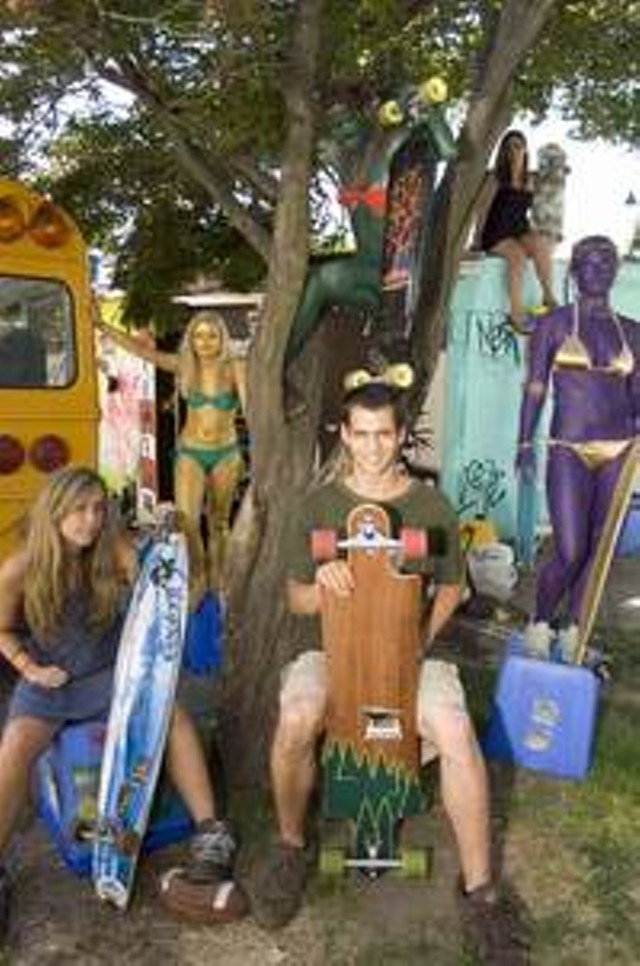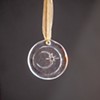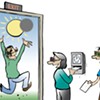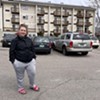Published July 4, 2007 at 11:55 a.m.
Will Deming’s skateboard lets out a raucous growl as he skids to a sideways stop at the intersection of Main and Battery streets in Burlington. It’s a gravelly, guttural sound, like an old man clearing his throat before he spits — an apt analogy, considering how some people feel about this form of recreation.
Despite the noise, Deming’s snowboard-like skid is buttery smooth. It’s an impressive feat when you’re decelerating to a dead stop on hard pavement from nearly 40 miles per hour, using nothing more than a homemade pair of padded gloves and a well-honed sense of balance. Deming, 21, drags his palms on the asphalt behind him in a controlled braking maneuver known among downhill skateboarders as “power-sliding,” or just “sliding.”
“Thrashin’ Thursday” is a fitting name for this weekly late-night event in which scads of local skateboarders bomb down the steep streets of Burlington, carving S-turns in the asphalt like snowboarders on a fresh powder day. It takes Deming, manager of Ridin High Skate Shop and an accomplished downhill rider, less than 10 minutes to get from the University of Vermont to the lake. It’s a balls-to-the-wall adrenaline rush with a high pucker factor. Without racing leathers and a full-face helmet, the activity isn’t recommended to anyone who’s fond of their skin or heavily invested in orthodontic work.
But if there’s one indelible rule in the rule-breaking world of skateboarding, it’s this: Skateboarders will always find places to ride, legal or otherwise. Whether they’re surfing the city’s parking garages, grinding the edges of public fountains or catching air off the concrete “Jersey” barriers on the abandoned I-189 connector, skaters are constantly re-envisioning the urban landscape in ways its designers never imagined.
And, many local skateboard enthusiasts say, it’s high time Burlington re-envisioned its own attitudes toward these four-wheeled wonders.
**************
It's been more than 35 years since hard-core surfers in Venice Beach, California, reinvented the popular ’60s play toy by skating in drought-emptied pools. In the process, they gave birth to legions of new, gravity-defying sports, among them snowboarding, perhaps its most affluent offspring. But here in that winter sport’s birthplace, there’s virtually no acknowledgment of skateboarding as a legitimate activity. Visit any Chamber of Commerce in the state, or search Vermont’s official tourism website, and you won’t find one mention of the sport.
Older than the mountain bike, cheaper than a pair of skis and more popular among American teens than baseball, the skateboard has had the staying power of dandelions — and commands as little respect. Even as the sport has gone mainstream through internationally televised events such as the X-Games, it languishes under a stigma as the ultimate tool of destruction for rebellious punk teens. Little wonder that one of the most in-your-face, anti-authority pop icons, Bart Simpson, is a consummate skateboarder.
Today, an estimated 13 million youths, most of them male, own skateboards and ride them on a regular basis. But except for people who share a house with a teenager or who ride themselves, most of us wouldn’t know a kickflip from a nosegrind. Other than the Talent Skate Park in South Burlington, the only indoor skating facility in the region, there are precious few places to ride — legally — in Vermont.
In Vermont, skateboarding isn’t a crime, but it’s not considered a right, either. Burlington has no ordinance that specifically forbids skateboarding, except for the wholesale ban on wheeled vehicles on Church Street and downtown sidewalks. State law is fuzzy on the issue. According to Deputy Chief Mike Schirling of the Burlington Police Department, skateboarders are considered “pedestrians” and hence prohibited from riding in traffic, even when they’re in a bike lane. This policy forbids those who use a skateboard as a means of transportation from riding in the street and on downtown sidewalks, effectively shutting them out of the city’s urban core.
Moreover, local skaters don’t always get off scot-free. When Kyle Anger, 20, got pulled over in Burlington a few weeks ago while riding his skateboard on the street, he was outraged. Anger (pronounced “Onjay”) doesn’t own a car and uses his longboard to commute to work.
He insists he was on the right side of the road and not weaving through traffic. “He tried to write me up for being a ‘pedestrian in the roadway with a play toy,’” Anger says. “I said, ‘Officer, do you know how much this board costs? Upwards of $600. This didn’t come from K-Mart.’”
On public property throughout the state and around the country, skateboarders are seen as minor annoyances at best. On private property, they’re considered vandals and trespassers. Pesky as fire ants, pernicious as termites and tenacious as cockroaches, skaters have been branded a wholesale threat to the public order and banned from most towns’ and cities’ sidewalks, streets, parking garages and other wheel-friendly terrain. Winooski, which recently underwent a major downtown renovation that left local skaters drooling at the new handrails to grind and steps to jump, now has a citywide prohibition on skateboards.
Admittedly, Vermont is more accepting than most places. Consider an incident that happened two weeks ago in Hot Springs, Arkansas. There, a local police officer apparently choked a 13-year-old skater and wrestled him to the ground — just for riding a skateboard on the sidewalk. Then, in a fit of rage, he grabbed two other skaters in headlocks, handcuffed them and threatened to pepper-spray them. In all, four skateboarders were arrested and cited for disorderly conduct and resisting arrest.
These days, digital video cameras are practically de rigueur skating gear, so the entire Arkansas incident was caught on videotape and posted on YouTube on June 21 — National Go Skateboarding Day. As a result, the arresting officer was placed on administrative leave. Hot Springs Mayor Mike Bush was quoted as saying, “Unfortunately, the video shows it pretty good.”
Unfortunately.
Of course, skateboarding bans aren’t always unwarranted. In the March 1998 issue of Landscape Architecture magazine, writer J. William Thompson explains in “A Good Thrashin’” how Albuquerque, New Mexico, learned its lesson the hard way when it unveiled a $9.8 million refurbishment of the Downtown Civic Plaza. Within hours of opening, skateboarders descended on the plaza, leaving deep gouges in the new fountain and benches, stripping the paint off handrails and marring the city logo. Shortly thereafter, Thompson notes, skateboarding downtown was nixed. Scores of other cities, including Washington, D.C., have brought the grinding to a halt.
But Thompson also writes that those problems tend to subside when cities provide adequate and updated facilities for skaters. Deputy Chief Schirling says that, in terms of citations, “Skateboarding has not been a thing for us for years.” In large measure, that’s due to the presence of the waterfront skate park.
It was seven years ago this week that Burlington opened its first permanent skate facility on the waterfront. The skaters who use it today — and they use the hell out of it, in numbers that exceed most other park facilities — probably have no idea that it took 10 years of political wrangling to get it built; the park was so controversial that neighbors brought a lawsuit to try to prevent its construction. The result was a court ruling that left the city with virtually no leeway to alter the park’s footprint or its hours of operation.
Today, the skate park is showing its age, both in form and in wear and tear. Parts of the ramps are peeling, wood screws are coming loose, and the planks are deteriorating. Recently, the Burlington Parks & Recreation Department removed the half-pipe ramp, partly because it was rotting and partly because local skaters said the space could be better used for more modern, street-course elements. “Clearly, at some point in the near future there should be a major reinvestment,” acknowledges Wayne Gross, director of Parks & Recreation. But local skaters voice little optimism that’ll happen soon.
“I don’t know why it’s so hard to get anything built here,” bemoans Brendan Foster, co-owner of Maven, a downtown skateboard and clothing shop. For years, Foster and his partner, Trina Zide, have been trying to get Burlington to invest in a new, modern concrete park. “It’s not the money, it’s not the weather. It seems to be more politics than anything else,” he adds.
Zide agrees. “It’s sad that the home of Burton [Snowboards] doesn’t have a great skate park in the city,” she says. “It’s really sad.”
In the last two years, Foster and Zide have sponsored local art auctions to raise money to renovate the park. To date, they’ve scraped together $6000 — woefully short of the tens or even hundreds of thousands of dollars needed to build a modern concrete facility.
****************
Near midnight on a recent Thrashin’ Thursday,18 local skateboarders disembark from the short yellow school bus that shuttles them from the waterfront to the highest paved spot in Burlington — the water tower parking lot on UVM’s Redstone campus. They’re here for their maiden run of the night.
Before they depart, the riders get a brief safety talk from Kebbek Skateboards, a small manufacturer in Montréal. In early June, he came to Vermont for a downhill competition on Mount Ascutney, a race that he predicts will be one of the world’s premiere skateboarding events in two or three years. “I’ve raced all over the world,” Comishin says, “and I’d have to say that that course is, if not the most challenging race course I’ve ever raced, then pretty close to it.”
On his trip back to Montréal, Comishin stopped for a ride in Burlington. His impression? It’s smokin’ hot. The longboard scene, he says, is poised to “blow up” here, provided the city doesn’t shut it down first. Burling- ton’s terrain is ideally suited to longboarding, as are its demographics — featuring a steady stream of outdoorsy, college-age kids with disposable income and a predilection for rapid downhill descent.
Other professional skaters have similar reactions. Marion Karr is a professional skateboarder from Statesville, North Carolina. After a recent visit to the Queen City, he practically gushed over Burlington’s downhill potential.
“To a mountain biker, Moab, Utah, is one of those places you just have to ride in your mountain-biking life,” he writes on the skateboarding site Silverfish. “After last night, I feel that way about Burlington. It’s a MUST RIDE if you’re a longboarder.”
Such endorsements won’t thrill most city elders or the local police, who cringe whenever they see a skateboarder carving turns down Battery Street in the midst of traffic.
“They’re just begging to be killed,” says Deputy Chief Schirling. “I’ve watched motorcycles go through those intersections and end up underneath a car. I can’t imagine what’s going to happen when one of those guys can’t stop.”
How dangerous is skateboarding? Local enthusiasts attribute official reluctance to invest in facilities like the skate park to the popular perception that skateboarding is a liability waiting to happen.
But recent statistics suggest that such worries are largely unfounded. Nationally, skateboarding injuries cause about 50,000 visits to the emergency room each year, with more than 1500 children and adolescents needing to be hospitalized, according to the American Academy of Orthopaedic Surgeons. While that may sound like a lot, skateboard injuries actually occur at a much lower rate (8.9 injuries per 1000 participants) than injuries in basketball (21.2 per 1000), football (20.7), bicycling (11.5) and snowboarding (11.2). In fact, the October 2002 issue of The Journal of Trauma described skateboarding as “a relatively safe sport.”
Vermont doesn’t collect much data on the prevalence of skateboard accidents. Fletcher Allen Health Care, the state’s largest hospital, doesn’t track emergency room visits by the mechanism of injury. Vermont Children’s Hospital has seen a jump in admissions resulting from skateboard injuries — from two in 2005 to six in 2006. While the hospital has already admitted five injured skateboarders in the first six months of this year, program manager Sue Victory cautions against reading too much into such small numbers.
As for the claim that skateboarding creates liability nightmares for municipalities, it doesn’t appear to hold up. In many other states, skateboarding has been declared a “hazardous activity,” a classification that indemnifies municipalities against lawsuits. Thompson discovered while researching his piece in Landscape Architecture that “Successful claims against cities for public skate parks are virtually nonexistent.”
Local skaters sum up the issue more bluntly. “We’re not going to sue you. We’re skateboarding!” says Jake Grossman-Christ, a 19-year-old who works at Burlington’s 802 Skate and Snowboard Shop. “You think if we fall down, we’re going to sue the city of Burlington for having stones on the street?”
*******************
What’s usually over-looked in public discussions of skateboarding — when such discussions occur at all — is the sheer artistry of the sport. Skateboarding has spawned a whole universe of accompanying art, from graphic designs to clothing to homespun videography. It’s also inspired some of the brightest lights in Burling- ton’s creative economy.
Michael Jager, 47, is a partner and creative director at the global design firm Jager Di Paola Kemp. An avid skateboarder, he’s long had a ramp in the basement of his office, where he and fellow JDK staffers ride for fun and creative inspiration. “The work that we’ve done in snowboarding was absolutely influenced by the relationship that I and the people in the studio have with skating,” Jager says, “and it still is.”
Jager once built the largest half-pipe ramp in Vermont — known affectionately among local skaters as “the Swamp Thing” — in the woods outside his Williston studio. “I would literally have dreams about skating a half-pipe before I ever had one,” he recalls. “I would watch videos every morning before I started designing. Then I’d go skate at night.”
Jake Burton Carpenter, the 53-year-old founder of Burton Snowboards, built the “Burton Bowl” skate ramp behind the company’s Burlington headquarters, where local skateboarders ride for free — as long as an employee is present. Seth Neary, a local graphic artist, videographer and co-owner of the Pursuit Gallery on Burlington’s waterfront, has been a skater for years. “Other than my family,” says Neary, 35, “skateboarding is everything I live and breathe for.”
This week, Neary premiered a new skateboard-inspired exhibit at the Pursuit Gallery: “Dune Wuz Here,” by Los Angeles-based artist and pro skateboarder Chris Pastras. Pastras, a co-founder with actor Jason Lee of Stereo Skateboards in L.A., got his start in the field by designing artwork for his skateboard decks. A recent design of his now appears on a Mountain Dew can.
Neary says skateboarding has been the impetus for much of his own work as a designer and videographer. Among his projects is the 1998 Burlington skateboard video “Beerlington,” which took home a local “Bessie” Award for best new voice in film.
“Skateboarders look at architecture completely differently than the average person,” Neary says. “You see flight of stairs, but we can tell you how many stairs are in that flight and whether we can jump them or kick-flip them. That’s how a skater thinks.”
In fact, a search on YouTube for “Vermont+skateboard” turns up more than 100 mostly homemade videos of local skateboarders performing tricks and maneuvers. As Jager at JDK explains, it’s a self-perpetuating form of expression: Kids will watch skateboard footage hundreds, sometimes thousands of times to learn and perfect new moves.
“When you see kids skating a ramp, or just street skating, it’s this progression session where they’re each inspiring and pushing and teaching and creating,” Jager continues. Unlike team sports, where competitors are ranked and sorted into first and second strings according to their ability, he says, skating is simultaneously an individual and collective activity.
Jager doesn’t get on his board as much as he used to. Still, he thinks it’s sad that Burlington lags so far behind other progressive communities around the country in recognizing that skateboarding is youth culture. Like other artists, he says, skateboarders are often misunderstood because of the “sideways stance they take in culture.”
Someday, perhaps, that stance will be the norm. For now, Deming and others like him will keep their form as they barrel down the hill — standing sideways, full-speed ahead.
VIDEO: Trashin' Thursday at Ridin' High
More By This Author
Speaking of...
-

Burlington Budget Deficit Balloons to $13.1 Million
Apr 25, 2024 -

The Café HOT. in Burlington Adds Late-Night Menu
Apr 23, 2024 -

Burlington Mayor Emma Mulvaney-Stanak’s First Term Starts With Major Staffing and Spending Decisions
Apr 17, 2024 -

Totally Transfixed: A Rare Eclipse on a Bluebird Day Dazzled Crowds in Northern Vermont
Apr 10, 2024 -

Middlebury’s Haymaker Bun to Open Second Location in Burlington’s Soda Plant
Apr 9, 2024 - More »
Comments
Comments are closed.
From 2014-2020, Seven Days allowed readers to comment on all stories posted on our website. While we've appreciated the suggestions and insights, right now Seven Days is prioritizing our core mission — producing high-quality, responsible local journalism — over moderating online debates between readers.
To criticize, correct or praise our reporting, please send us a letter to the editor or send us a tip. We’ll check it out and report the results.
Online comments may return when we have better tech tools for managing them. Thanks for reading.














































